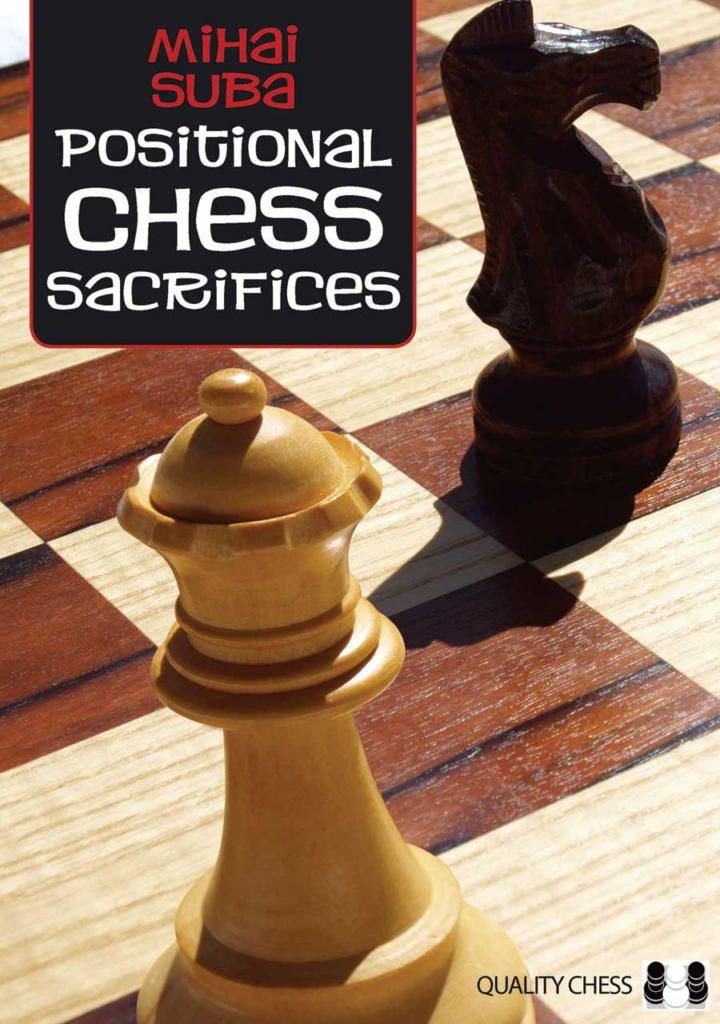The idea of giving up material in chess has always intrigued me, particularly when there isn’t a clear or quick reward.
In the games of the great masters, I have seen many exquisite instances of such sacrifices, but I have often found it difficult to comprehend the reasoning and intuition that went into them.
For this reason, I was excited to read Mihai Suba’s book Positional Chess Sacrifices.
The book contains an assortment of positional sacrifices used by Suba to build pressure, complicate the game, or take advantage of vulnerabilities. It also includes some of the great positions and games by other players.
Suba organizes the book with sections that concentrate on several kinds of positional sacrifices.
There are 19 chapters in total. The book begins with a theme introduction and ends with games and exercises with annotations.
Though there are some excellent games from great world champions like Alekhine, Botvinnik, Fischer, Karpov, and Kasparov, the majority of the games are from Suba’s own practice. The book’s conclusion contains the answers to the demanding and educational tasks.
Who is the Author?
Mihai Suba, a chess player from Romania and Spain, was given the Grandmaster title in 1978 after winning the title of International Master in 1975.
He began playing chess at the late age of 19, having been born in Bucharest, Romania, in 1947.
He competed in several international events, where he had some impressive results, and he won the Romanian Chess Championship three times.
After playing for England for a few years after his 1988 Romanian desertion, he returned to Romania in 1992 to play for them. He later changed to the Spanish national federation in 2017.
He is still an active player of chess, and he and Larry Kaufman were jointly proclaimed the 2008 World Senior Chess Championship winners retrospectively. He is among the most unique and fascinating chess writers of our day.
Chapters Summarised
This book is about 376 pages with a lengthy introduction, 19 chapters, End Notes, and Game Indexes.
Chapter 1 talks about open games which started with openings involving gambit lines…such as the Evans gambit, King’s gambit, the Italian game e.t.c
Chapters 2 – 7 talk about games containing sacrifices in specific openings which are the Ruy Lopez, Alekhine, French, Caro Kann, and the Sicilian defense. It also includes the semi-open games.
Chapters 8 and 9 discuss closed and semi-closed games respectively.
Chapters 10 – 12 talked about other openings containing sacrificial prowess like the Modern Benoni, Nimzo-Indian, and Queen Indian Defense respectively.
Chapter 13 talks about flank openings like the English and Hedgehog opening.
Chapters 14 – 19 talk about specific types of sacrifices found in both middlegames and endgames such as pawn sacrifices, exchange sacrifices, minor piece sacrifices, queen sacrifices, and other sacrifice motifs.
Who Should Read This Book?
This book is for chess players of all levels from 1300 up to 2500.
Players who want to improve their understanding and skills in positional sacrifices, which are sacrifices that are not based on quick benefits, but on long-term advantages or strategic goals should read this.
Mihai Suba, a grandmaster and author, explains that in chess, giving up pieces is a bold way to gain an advantage. The most profound type of piece sacrifice is called a positional sacrifice. This type of sacrifice requires a lot of skill and intuition because it’s hard to predict the outcome. They are usually a mystery to average players, but Mihai Suba explains them in an entertaining way.
The book is also for chess lovers who appreciate the beauty and creativity of chess, and who want to learn from the author’s experience and insights. He shows mastery in positional sacrifices.
What I Like About This Book
The sacrifices made in this book are often non-mainstream theoretical sacrifices, and the examples are usually carefully picked. This makes the book unique.
I also like how the author summarises the key points of the game and reminds the reader of the aspects that are most important to keep in mind in his “post-game reflections”
What I Don’t Like About This Book
Some things I found out that are not right are:
– The book seems to be too subjective and biased, and the author often overestimated his own sacrifices or underestimated his opponents’ moves.
– The book seemed challenging. It might be too difficult and advanced for beginner levels, and another thing is that the author did not provide enough explanations or guidance for the exercises making it less interesting and frustrating for newbies.
– I also noted that the book had some typographical errors and inconsistencies.
– I have plenty of grounds to be skeptical since it seems that the author’s assessment is mostly based on engine evaluation.
Mihai Suba’s excessive dependence on engines makes sense since, given his senior age, he may not be as strategically sound and energetic as he once was.
Final Thoughts
In addition to being educational, the book is enjoyable and motivating.
With a wealth of tales and insights from his chess career and life, Suba writes in a colorful and funny way.
In addition, he offers his thoughts and opinions on a range of chess-related subjects, including computers, psychology, openings, and chess history.
He is not afraid to voice his opinions and critiques; sometimes he does so in a caustic or controversial manner, but he always does so with respect and a sense of humor.

